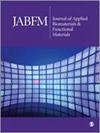Physicomechanical, morphological and tribo-deformation characteristics of lightweight WC/AZ31B Mg-matrix biocomposites for hip joint applications
IF 3.1
4区 医学
Q2 BIOPHYSICS
Journal of Applied Biomaterials & Functional Materials
Pub Date : 2024-05-04
DOI:10.1177/22808000231214359
引用次数: 0
Abstract
Exploring high strength materials with a higher concentration of reinforcements in the alloy proves to be a challenging task. This research has explored magnesium-based composites (AZ31B alloy) with tungsten carbide reinforcements, enhancing strength for medical joint replacements via league championship optimisation. The primary objective is to enhance medical joint replacement biomaterials employing magnesium-based composites, emphasising the AZ31B alloy with tungsten carbide reinforcements. The stir casting method is utilised in the manufacture of magnesium matrix composites (MMCs), including varied percentages of tungsten carbide (WC). The mechanical characteristics, such as micro-hardness, tensile strength, and yield strength, have been assessed and compared with computational simulations. The wear studies have been carried out to analyse the tribological behaviour of the composites. Additionally, this study investigates the prediction of stress and the distribution of forces inside bone and joint structures, therefore offering significant contributions to the field of biomedical research. This research contemplates the use of magnesium-based MMCs for the discovery of biomaterials suitable for medical joint replacement. The study focuses on the magnesium alloy AZ31B, with particles ranging in size from 40 to 60 microns used as the matrix material. Moreover, the outcomes have revealed that when combined with MMCs based on AZ31B-magnesium matrix, the WC particle emerges as highly effective reinforcements for the fabrication of lightweight, high-strength biomedical composites. This study uses the league championship optimisation (LCO) approach to identify critical variables impacting the synthesis of Mg MMCs from an AZ31B-based magnesium alloy. The scanning electron microscopy (SEM) images are meticulously analysed to depict the dispersion of WC particulates and the interface among the magnesium (Mg) matrix and WC reinforcement. The SEM analysis has explored the mechanisms underlying particle pull-out, the characteristics of inter-particle zones, and the influence of the AZ31B matrix on the enhancement of the mechanical characteristics of the composites. The application of finite element analysis (FEA) is being used in order to make predictions regarding the distribution of stress and the interactions of forces within the model of the hip joint. This study has compared the physico-mechanical and tribological characteristics of WC to distinct combinations of 0%, 5%, 10% and 15%, and its impact on the performance improvements. SEM analysis has confirmed the findings’ improved strength and hardness, particularly when 10%–15% of WC was incorporated. Following the incorporation of 10% of WC particles within Mg-alloy matrix, the outcomes of the study has exhibited enhanced strength and hardness, which furthermore has been evident by utilising SEM analysis. Using ANSYS, structural deformation and stress levels are predicted, along with strength characteristics such as additional hardness of 71 HRC, tensile strength of 140–150 MPa, and yield strength closer to 100–110 MPa. The simulations yield significant insights into the behaviour of the joint under various loading conditions, thus enhancing the study’s significance in biomedical environments.用于髋关节的轻质 WC/AZ31B 镁基质生物复合材料的物理力学、形态学和三重变形特性
事实证明,探索合金中强化剂浓度更高的高强度材料是一项具有挑战性的任务。本研究探索了含有碳化钨增强材料的镁基复合材料(AZ31B 合金),通过联盟冠军优化提高医用关节置换材料的强度。研究的主要目的是利用镁基复合材料增强医用关节置换生物材料的强度,重点是带有碳化钨增强材料的 AZ31B 合金。镁基复合材料(MMC)的制造采用搅拌铸造法,其中包括不同比例的碳化钨(WC)。对微观硬度、拉伸强度和屈服强度等机械特性进行了评估,并与计算模拟进行了比较。此外,还进行了磨损研究,以分析复合材料的摩擦学行为。此外,这项研究还对骨骼和关节结构内部的应力和力分布进行了预测,从而为生物医学研究领域做出了重大贡献。本研究考虑使用镁基 MMC 来发现适用于医用关节置换的生物材料。研究的重点是镁合金 AZ31B,基体材料的颗粒大小从 40 微米到 60 微米不等。此外,研究结果表明,当与基于 AZ31B 镁基质的 MMC 相结合时,WC 颗粒成为制造轻质、高强度生物医学复合材料的高效增强材料。本研究采用联盟冠军优化(LCO)方法来确定影响从基于 AZ31B 的镁合金合成镁 MMC 的关键变量。对扫描电子显微镜(SEM)图像进行了细致分析,以描述碳化钨颗粒的分散情况以及镁(Mg)基体和碳化钨增强体之间的界面。扫描电子显微镜分析探讨了颗粒拉出的内在机制、颗粒间区域的特征以及 AZ31B 基体对增强复合材料机械特性的影响。有限元分析(FEA)的应用是为了预测髋关节模型中的应力分布和力的相互作用。这项研究比较了 0%、5%、10% 和 15% WC 不同组合的物理机械和摩擦学特性及其对性能改善的影响。扫描电子显微镜分析证实了研究结果对强度和硬度的改善作用,尤其是在添加 10%-15%的 WC 时。在镁合金基体中加入 10% 的碳化钨颗粒后,研究结果表明强度和硬度都得到了提高,这一点在 SEM 分析中也得到了证实。使用 ANSYS 预测了结构变形和应力水平,以及强度特性,如硬度增加到 71 HRC,抗拉强度达到 140-150 兆帕,屈服强度接近 100-110 兆帕。模拟结果有助于深入了解接头在各种加载条件下的行为,从而增强了这项研究在生物医学环境中的意义。
本文章由计算机程序翻译,如有差异,请以英文原文为准。
求助全文
约1分钟内获得全文
求助全文
来源期刊

Journal of Applied Biomaterials & Functional Materials
BIOPHYSICS-ENGINEERING, BIOMEDICAL
CiteScore
4.40
自引率
4.00%
发文量
36
审稿时长
>12 weeks
期刊介绍:
The Journal of Applied Biomaterials & Functional Materials (JABFM) is an open access, peer-reviewed, international journal considering the publication of original contributions, reviews and editorials dealing with clinical and laboratory investigations in the fast growing field of biomaterial sciences and functional materials.
The areas covered by the journal will include:
• Biomaterials / Materials for biomedical applications
• Functional materials
• Hybrid and composite materials
• Soft materials
• Hydrogels
• Nanomaterials
• Gene delivery
• Nonodevices
• Metamaterials
• Active coatings
• Surface functionalization
• Tissue engineering
• Cell delivery/cell encapsulation systems
• 3D printing materials
• Material characterization
• Biomechanics
 求助内容:
求助内容: 应助结果提醒方式:
应助结果提醒方式:


